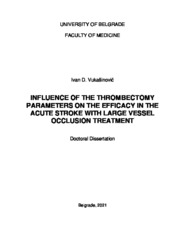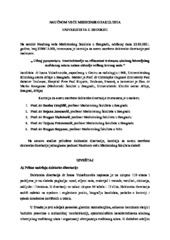Приказ основних података о дисертацији
Influence of the thrombectomy parameters on the efficacy in the acute stroke with large vessel occlusion treatment
Uticaj parametara trombektomije na efikasnost tretmana akutnog ishemijskog moždanog udara nakon okluzije velikog krvnog suda
| dc.contributor.advisor | Cognard, Christophe | |
| dc.contributor.other | Ercegovac, Marko | |
| dc.contributor.other | Grujičić, Danica | |
| dc.contributor.other | Jovanović, Dejana | |
| dc.contributor.other | Mašulović, Dragan | |
| dc.creator | Vukašinović, Ivan | |
| dc.date.accessioned | 2022-01-21T15:33:01Z | |
| dc.date.available | 2022-01-21T15:33:01Z | |
| dc.date.issued | 2021-09-29 | |
| dc.identifier.uri | http://eteze.bg.ac.rs/application/showtheses?thesesId=8472 | |
| dc.identifier.uri | https://fedorabg.bg.ac.rs/fedora/get/o:24871/bdef:Content/download | |
| dc.identifier.uri | http://vbs.rs/scripts/cobiss?command=DISPLAY&base=70036&RID=54044425 | |
| dc.identifier.uri | https://nardus.mpn.gov.rs/handle/123456789/18905 | |
| dc.description.abstract | Acute ischemic stroke (AIS) is an acute impairment of brain function caused by a central nervous system focal injury of a vascular origin. The cause is a sudden blockage of blood flow to the brain neural tissue caused by arterial occlusion. AIS is the second most common primary cause of death in Europe, accounting for 9% of deaths in men and 12% of deaths in women annually. Moreover, mortality within the first month after the incident is around 30%. Half of the survivors lose their independence in everyday life, as it is the leading cause of long-term disability. From a socio-economic point of view, AIS represents a major public health burden worldwide, mainly due to the high hospitality rate of severely disabled patients and consequently high costs of rehabilitation and medical care. The main goals of AIS treatment are the recanalization of occluded blood vessels and potential reperfusion of remained viable brain tissue. Until 2015, the only proven reperfusion technique was the application of recombinant tissue plasminogen activator (IV tPA) administered less than 4.5 hours from symptom onset. However, several randomized controlled trials (RCTs) promoted an endovascular treatment approach and proved that mechanical thrombectomy (MT) is safe and effective for the treatment of anterior circulation large vessel occlusion (ACLVO), in comparison with traditional AIS treatment. Although MT is currently an accepted standard of care, there are still a lot of pending questions to be clarified. For instance, issues about widening MT indications, best technique, practical organization, minimal required imaging, type of anesthesia, patient triage and transport, the best management of tandem occlusion (TO), and the influence of the clot composition on retrieval efficacy need to be additionally clarified in future. Another major issue is the applicability of RCTs results achieved in the well-organized centers and in highly-controlled settings, compared to a real-world situation, especially in developing country medical systems which are dealing with lack of trained personnel, shortage of appropriate financial and material support, lower basic health level of the population, etc. Therefore, this dissertation aimed to evaluate the influence of different thrombectomy parameters on the treatment of AIS in Belgrade and Toulouse cohort study populations. Material and methods: This double center observational cohort study with the pragmatic care trial context for AIS patients treated with MT included data from 284 patients at Toulouse University prospective stroke registry and data from 82 patients at The Clinical Center of Serbia prospective stroke registry. Clinical and radiological data collection of treated cases were from January 2015 to January 2017 at Toulouse University center, and from January 2018 to January 2020 at The Clinical Center of Serbia. Moreover, additional collected data related to the anesthesia management during MT procedure in the Toulouse mono-center cohort were for the period from January 2014 until July 2016. The eligible cases were selected using the following inclusion criteria: (1) verified ACLVO by computed tomography (CT) angiography or magnetic resonance (MR) angiography; (2) MT initiated within the 6 hours from symptoms onset regardless of the use of intravenous recombinant tissue plasminogen activator (IV tPA). On the other hand, the exclusion criteria were as follows: (1) presence of intracranial hemorrhage (on MR or CT); (2) absence of the ACLVO; (3) small artery occlusion (distal from M2 division of the middle cerebral artery) or in the territory of posterior circulation (vertebrobasilar distribution); (4) MT initiated after 6 hours from symptom onset; (5) age below 18 years. From prospective stroke databases of both centers, several parameters were collected: clinical data (age, gender, pre-treatment National Institutes of Health Stroke Scale (NIHSS) score, side of occlusion, level of occlusion, use of IV tPA, and type of anesthesia), time metrics (time of stroke onset, time of arrival at the stroke center, time of imaging, time of arrival in the angio-suite, time of arterial puncture (AP) and time of recanalization/last image), imaging data (on MR or CT),the Alberta Stroke Program Early CT Score (ASPECTS) was calculated on diffusion-weighted imaging (DWI) or CT to assess the extent of the ischemic core, endovascular treatment data and angiographic outcome on modified thrombolysis in cerebral infarction (mTICI) score, and safety and clinical outcomes (complications and intracranial hemorrhage, stroke severity measured on the NIHSS at 24h, the degree of disability assessed on modified... | sr |
| dc.description.abstract | Akutni ishemijski moždani udar (AIMU) je akutno oštećenje moždane funkcije izazvano fokalnim oštećenjem centralnog nervnog sistema usled poremećaja cirkulacije krvotoka. Uzrok je iznenadni prekid krvotoka moždanog tkiva uzrokovan okluzijom arterijskog krvnog suda. AIMU je drugi najčešći pojedinačni uzrok smrti u Evropi, čineći 9% smrtnih slučajeva kod muškaraca i 12% smrtnih slučajeva kod žena svake godine. Štaviše, mortalitet u prvom mesecu nakon AIMU-a je oko 30%. Vodeći je uzrok trajnog invaliditeta, sa gubitkom sposobnosti za samostalni život. Sa socioekonomskog aspekta, AIMU predstavlja veliki socijalno-zdravstveni problem širom sveta, uglavnom zbog visoke stope hospitalizacije pacijenata sa teškom kliničkom slikom i posledičnih visokih troškova rehabilitacije i nege. Glavni ciljevi lečenja AIMU-a su rekanalizacija okludiranih krvnih sudova i posledična reperfuzija još uvek vijabilnog moždanog tkiva. Do 2015. godine, jedina dokazana reperfuziona terapija bila je intravenska aplikacija rekombinantnog tkivnog aktivatora plazminogena (IV tPA) primenjenog manje od 4,5 sata od pojave simptoma. Međutim, nekoliko randomiziranih kontrolisanih istraživanja (RCTs) promovisalo je endovaskularno lečenje, pri čemu je ustanovljeno da je mehanička trombektomija (MT) okluzije velikog krvnog suda prednje arterijske cirkulacije (ACLVO) sigurna i efikasna metoda u poređenju sa tradicionalnim tretmanom AIMU-a. Iako je MT trenutno prihvaćena kao standard lečenja za pacijente sa proksimalnom okluzijom prednje moždane cirkulacije, još uvek ima mnogo nerazjašnjenih pitanja. Na primer, proširenje indikacija za primenu MT, odabir optimalne tehnike, praktična organizacija rada, minimalno neophodna dijagnostika, vrsta anestezije, trijaža i transport pacijenta, adekvatan tretman tandem okluzije (TO), uticaj strukture tromba na efikasnost terapije, nepoznanice su koje u budućnosti treba dodatno razjasniti. Još jedno veoma važno pitanje je primenljivost rezultata RCTs postignutih u dobro organizovanim centrima i visoko kontrolisanim uslovima, u poređenju sa stvarnom situacijom na terenu, posebno u zdravstvenim sistemima zemalja u razvoju koji se bore sa nedostatkom obučenog osoblja, odgovarajuće finansijske i materijalne podrške, nižim osnovnim zdravstvenim nivoom populacije, itd. Stoga je ova doktorska disertacija imala za cilj da proceni uticaj različitih parametara trombektomije na efikasnost tretmana AIMU-a u ispitivanim populacijama pacijenata u Beogradu i Tuluzu. Materijal i metod: Ova opservaciona kohortna studija sprovedena u dva istraživačka centra obuhvatila je podatke 284 pacijenta iz registra AIMU-a Univerziteta u Tuluzu i podatke 82 pacijenta iz registra AIMU-a Kliničkog Centra Srbije. Prikupljanje kliničkih i radioloških podataka lečenih pacijenata bilo je od januara 2015. godine do januara 2017. godine za Univerzitetski centar u Tuluzu, i od januara 2018. godine do januara 2020. godine za Klinički centar Srbije. Dodatno, prikupljani podaci koji se odnose na primenu različitih vidova anestezije tokom MT iz Univerzitetskog centra u Tuluzu odnose se na period od januara 2014. godine do jula 2016. godine. U studiju su uključeni pacijenti koji su ispunjavali sledeće kriterijume uključenja: (1) verifikovana ACLVO primenom kompjuterizovane tomografske (CT) angiografije ili magnetno rezonantne (MR) angiografije; (2) MT započeta u roku od 6 sati od pojave simptoma, bez obzira na primenu IV tPA. S druge strane, kriterijumi za isključenje bili su sledeći: (1) prisustvo intrakranijalnog krvarenja na (MR ili CT); (2) odsustvo ACLVO; (3) okluzija male arterije (distalno od M2 segmenta srednje velikomoždane arterije) ili u teritoriji zadnje cirkulacije (vertebrobazilarni sliv); (4) MT započet nakon 6 sati od pojave simptoma; (5) starost ispod 18 godina. Iz prospektivnih baza podataka o AIMU-u u oba istraživačka centra prikupljani su podaci o sledećim parametrima: klinički podaci (starost, pol, vrednost „National Institutes of Health Stroke Scale“ (NIHSS) skora pre tretmana, strana okluzije, nivo okluzije, upotreba IV tPA i vrsta anestezije), vremenski intervali (vreme početka AIMU-a, vreme dolaska u angio-salu, vreme dijagnostičkog snimanja, vreme dolaska u specijalizovanu zdravstvenu ustanovu, vreme arterijske punkcije (AP) i vreme rekanalizacije/poslednje radiografije), podaci o radiološkoj dijagnostici (MR ili CT),„Alberta Stroke Program Early CT Score“ (ASPECTS) je određivan analizom na DWI ili CT kako bi se odredila veličina zone infarkta, podaci o endovaskularnom lečenju i angiografski ishod putem „modified thrombolysis in cerebral infarction“ (mTICI) procene, kao i bezbednosni i klinički ishodi (komplikacije, intracerebralno krvarenje, klinička težina moždanog udara određena NIHSS skorom nakon 24 sata i stepen invaliditeta procenjen putem „modified Rankin scale“ (mRS) tri meseca nakon otpusta... | en |
| dc.format | application/pdf | |
| dc.language | en | |
| dc.publisher | Универзитет у Београду, Медицински факултет | sr |
| dc.rights | openAccess | en |
| dc.rights.uri | https://creativecommons.org/licenses/by-nc-nd/4.0/ | |
| dc.source | Универзитет у Београду | sr |
| dc.subject | Acute ischemic stroke | sr |
| dc.subject | Akutni ishemijski moždani udar | en |
| dc.subject | large cerebral vessel occlusion | sr |
| dc.subject | mechanical thrombectomy | sr |
| dc.subject | computed tomography | sr |
| dc.subject | magnetic resonance imaging | sr |
| dc.subject | ASPECTS | sr |
| dc.subject | NIHSS | sr |
| dc.subject | mRs | sr |
| dc.subject | mTICI | sr |
| dc.subject | okluzija velikih cerebralnih krvnih sudova | en |
| dc.subject | mehanička trombektomija | en |
| dc.subject | magnetna rezonanca | en |
| dc.subject | kompjuterizovana tomografija | en |
| dc.subject | ASPECTS | en |
| dc.subject | NIHSS | en |
| dc.subject | mRs | en |
| dc.subject | mTICI | en |
| dc.title | Influence of the thrombectomy parameters on the efficacy in the acute stroke with large vessel occlusion treatment | sr |
| dc.title.alternative | Uticaj parametara trombektomije na efikasnost tretmana akutnog ishemijskog moždanog udara nakon okluzije velikog krvnog suda | en |
| dc.type | doctoralThesis | |
| dc.rights.license | BY-NC-ND | |
| dcterms.abstract | Цогнард, Цхристопхе; Јовановић, Дејана; Грујичић, Даница; Машуловић, Драган; Ерцеговац, Марко; Вукашиновић, Иван; | |
| dc.identifier.fulltext | http://nardus.mpn.gov.rs/bitstream/id/141995/Izvestaj_Komisije_12045.pdf | |
| dc.identifier.fulltext | http://nardus.mpn.gov.rs/bitstream/id/141994/Disertacija_12045.pdf | |
| dc.identifier.rcub | https://hdl.handle.net/21.15107/rcub_nardus_18905 |



